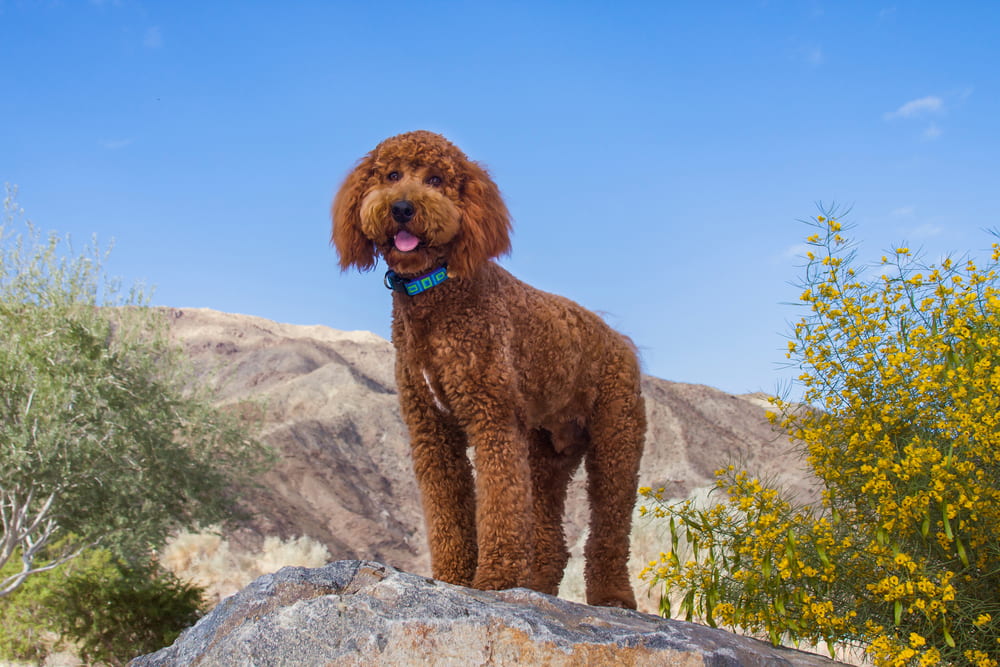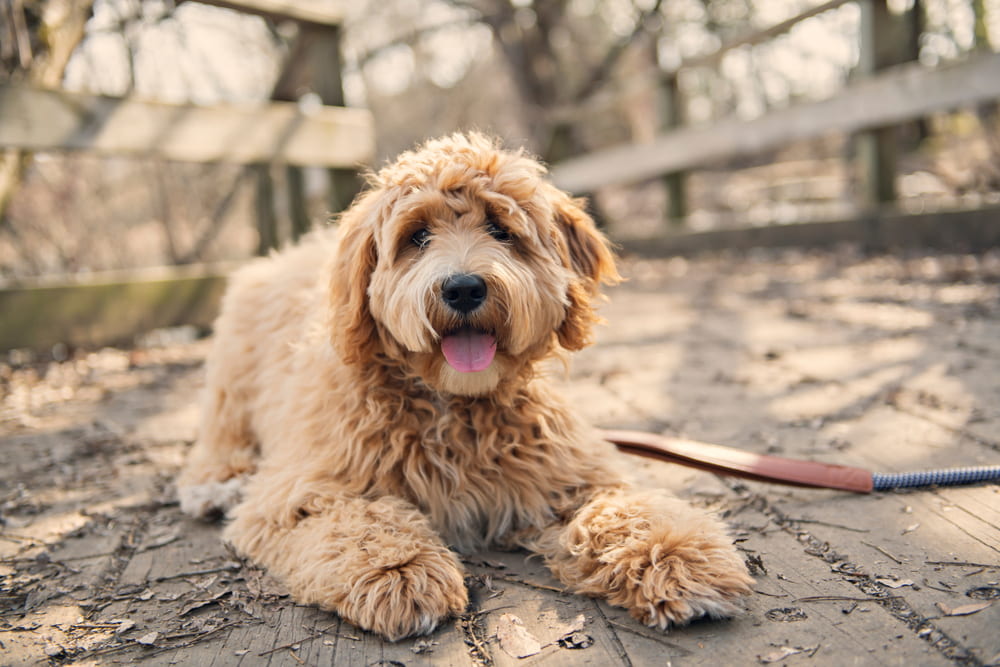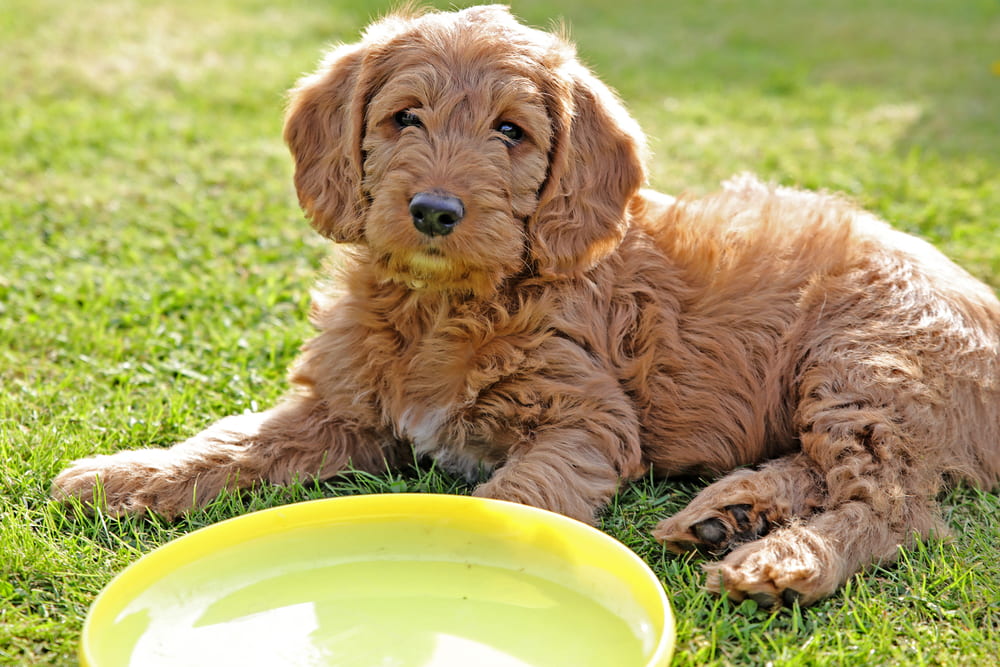Labradoodle

Breed Details
- Average Height: Miniature: 14 to 16 inches; Medium: 17 to 20 inches; Standard: 21 to 24 inches
- Average Weight: 15 to 65 pounds
- Coloring: Black, yellow, caramel and chocolate
- Coat Type: Flat, wavy, curly
- Dog Breed Group: Hybrid
- Average Lifespan: 12 to 14 years
-
Key Personality Traits:
Affectionate
Energetic
Good with Kids
Loyal
The Labradoodle, a cross between a Labrador Retriever and a Poodle, is a sought after mixed breed because it combines popular traits from both beloved dogs.
“People gravitate toward Labradoodles because they want to have the best of both worlds,” explains the founder of Michigan Doodle Rescue Connect, who goes by the moniker Nana Doodle.
The designer dogs might be growing in popularity but the Labradoodle is not the right breed for everyone. If you’re considering adopting a Doodle, keep reading.
History and Origin
Labradoodles, now a popular designer breed, started out as a one-off attempt to breed a hypoallergenic service dog. The creator, Australian Wally Conron, the former head breeder for the Australian Guide Dog Association, bred a Labrador Retriever and a Poodle hoping that the mixed breed, which combined two well-known guide dogs, would be low-shedding.
The Labradoodle, which a New York Times article called a “ubiquitous, mopheaded designer dog,” became a fast Instagram sensation and is now popular throughout North America. It also inspired copycat “doodle” breeds, including the Goldendoodle, a mix of a Golden Retriever and a Poodle; and the Bernedoodle, a mix between a Bernese Mountain Dog and a Poodle.
The American Kennel Club doesn’t recognize the Labradoodle as an official breed. The Worldwide Australian Labradoodle Association, an international organization focused on improving the breed, created its own breed standard. The breed standard also allows the Cocker Spaniel to be part of the Labradoodle mix.
Types of Labradoodles

As the breed grows more popular, so do the number of variations on the original Labradoodle. Now, there are Miniature Labradoodles (Labrador Retrievers crossed with Miniature Poodles) that reach just 14 to 16 inches tall; Medium Labradoodles that are between 17 and 20 inches tall; and Standard Labradoodles, which can be between 21 and 24 inches tall and weigh up to 65 pounds.
Since this is an ever-evolving breed, there are also F1, F2, and F1b Labradoodles.
F1 Labradoodles are a cross between a Labrador Retriever and a Poodle, creating a “first generation” Labradoodle that is 50 percent Labrador Retriever, 50 percent Poodle. These dogs might not be hypoallergenic and may still shed.
An F1b Labradoodle is the cross between a Poodle and an F1 Labradoodle. The resulting mix is 75 percent Poodle and 25 percent Labrador Retriever. As the dogs acquire more Poodle characteristics, the amount of shedding goes down and the likelihood that the dogs are hypoallergenic goes up.
An F2 Labradoodle is a mix of an F1b Labradoodle and a Poodle, creating a breed that is 87 percent Poodle and just 13 percent Labrador Retriever.
Within these variations, breeders might choose to breed Poodles to Yellow Labrador Retrievers (to create a dog known as a Golden Labradoodle) or a Chocolate Labrador retriever (to create a Chocolate Labradoodle).
Labradoodle Physical Characteristics

Even though Labradoodles are becoming more common, their curly coats and expressive eyes still attract a lot of attention.
Standard Labradoodles can stand 21 to 24 inches tall and weigh up to 65 pounds and are the most common of the designer doodle breeds. The breed also comes in miniature (14 to 16 inches tall and weighing as little as 15 pounds) and medium (17 to 20 inches tall) sizes.
Nana Doodle notes that the dogs can have several variations in coat coloring and type from smooth coats and wavy coats to coats made up of tight, soft curls.
The Worldwide Australian Labradoodle Association refers to these different coat types as:
Hair coat, which similar to the longer, thick hair of a Labrador Retriever and common on earlier generation or F1 breeds)
Wool coat, which is dense and similar in texture to lamb’s wool with hair that hangs in tight or spiraling curls and is low-to non-shedding.
Fleece coat, which has a silky texture and straight to way curls. The fleece coat is also low-to non-shedding.
Labradoodle Temperament

Labradoodles are a mix of two of the most popular dog breeds and Nancy Doodle believes that the dogs exhibit personality traits from each breed.
“Their temperament depends on the amount of genetics that each [dog] takes on,” she explains. “More times than not, they take after the Labrador Retriever. They are very loving, very smart, very loyal, eager to please and make great companions.”
The breed is known for its outgoing nature. Labradoodles will happily hang out at home while their owners are at work but form strong bonds with their owners and love being part of family activities.
Labradoodles are patient with dog-savvy children and get along well with other family pets, including cats.
“They are great dogs for first time dog owners,” Doodle says.
Similar to Labrador Retrievers and Poodles, Labradoodles are energetic and need regular exercise. A brisk walk around the block might do for some of these dogs but most prefer high octane activities such as running, hiking, swimming, games of fetch and romps at the dog park, according to Dr. Christian Latimer, a surgeon at Veterinary Referral Hospital of Hickory.
Labradoodles, like their Poodle parents or grandparents, are intelligent and require early and consistent training. Latimer recommends a basic obedience class and regular positive, rewards-based training at home, adding, “It sets the tone for good behavior for the lifetime of the dog.”
Labradoodle Care Guide

Like all dog breeds, Labradoodles need regular vet care, a high quality diet, exercise and grooming to ensure they live long, healthy lives.
Diet and Nutrition
Feed a Labradoodle a commercial diet formulated for their age and size. Your veterinarian might recommend feeding a standard Labradoodle a diet for large breed, active dogs to ensure it has the calories and nutrients it needs for proper growth and development. Look for foods made for large breeds that meet AAFCO guidelines.
Exercise and Activity
Labradoodles make great dogs for on-the-go families, Latimer says. Both Labrador Retrievers and Poodles are both active dog breeds who excel in dog sports such as agility, obedience, tracking, and dock diving and Labradoodles might enjoy those activities, too. Offering a combination of physical activity and mental stimulation (through games like fetch) are important for healthy bodies and minds.
Grooming and Nail Care
The amount of grooming a Labradoodle requires depends on its coat type. Nancy Doodle notes that many Labradoodles are “wash and go” but those with curly to wavy coats need a professional groomer to prevent their curls from forming webs that can be painful and—if left untreated—lead to skin infections. In addition to regular brushing, Labradoodles with tight curly coats should benefit from professional grooming every 8 to 10 weeks.
Regular nail trims and ear cleaning, occasional baths and annual dental cleanings will help keep Labradoodles looking and feeling their best.
Labradoodle Health Issues

As a mix of two breeds, Labradoodles can develop health conditions that are common in both Labrador Retrievers and Poodles—and might even be at increased risk of some diseases, according to Latimer.
“By mixing two breeds, the new breed is susceptible to the common diseases in each breed,” he explains.
These are some of the most common health issues in Labradoodles:
Ear Infections: Both Labrador Retrievers and Poodles have floppy ears that make them susceptible to otitis externa or inflammation in the ear canals. The infections can be chronic, causing pain and discomfort. “Keep their ears clean and if you notice symptoms, call your vet immediately,” Latimer advises.
ACL Tears: A rupture of the anterior cruciate ligament that stabilizes the inside of the knee is common in Labrador Retrievers and the condition also plagues Labradoodles, according to Latimer. An ACL tear causes pain and often lameness in the limb and mobility issues. Aging, obesity, genetics are all risk factors for ACL tears.
Hip Dysplasia: Larger breeds, including standard Labradoodles, are at higher risk for hip dysplasia, according to Latimer. Hip dysplasia is diagnosed when the femur fails to align with the hip socket. The condition causes pain and reduces quality of life.
Eye Issues: Research shows that Labradoodles have higher rates of multifocal retinal dysplasia or small folds in the tissue of the retina that can cause vision loss and blindness, than Labrador Retrievers. It can be genetic.
Interesting Labradoodle Facts
Celebrities like Jennifer Aniston, Tiger Woods, and Jamie Lee Curtis have all owned Labradoodles.
A 2020 study into breed genetics found that Labradoodles get a far higher percentage of their genetics from Poodles than Labrador retrievers. Despite being considered a new breed, researchers noted, “[the] Labradoodle is largely poodle with an excess of poodle alleles related to coat type.”
Labradoodle Adoption Tips and Things to Consider

Labradoodles are a newer breed and there are still just a handful of rescue organizations devoted to rescuing and rehoming the mixed breed dogs.
Labradoodle rescues in the U.S. include:
- Michigan Doodle Rescue Connect
- IDOG Rescue
- Doodle Rock Rescue
- Doodle Dandy Rescue
- Doodle Rescue Collective
These groups and organizations focus on all Doodle breeds and not just Labradoodles. Rescue groups focused the origin breeds—Labrador Retrievers, Golden Retrievers, and Poodles—might also take Doodle mixed breeds into the rescue.
It is possible to find Labradoodles in shelters and through rescue groups, but Nana Doodle warns that it can take a while to match families with available dogs because of the long list of families wanting to adopt the mixed breed dogs.
Labradoodle FAQs

Labradoodles are wonderful mixed breed dogs, but before welcoming one into your family, it’s important to know all of the facts and what to expect. Here are some commonly asked questions about the Labradoodle dog breed.
Do Labradoodles Shed?
It depends. Labradoodles have several different coat types and some are more prone to shedding than others. A Labradoodle that is a result of crossbreeding a purebred Labrador Retriever with a purebred Poodle is more prone to shedding than dogs that are bred from second-and third-generation Labradoodles.
How Long Do Labradoodles Live?
The lifespan of a Labradoodle is 12 to 14 years.
Are Labradoodles Smart?
Yes. Labradoodles are a result of mixing a Labrador Retriever and Poodle, breeds that are highly regarded for their intelligence.
When Do Labradoodles Stop Growing?
Labradoodles reach maturity around 2 years of age.
Do Labradoodles Smell?
In general, no, Labradoodles do not smell. Their low-to non-shedding coats tend to be low odor but Labradoodles that go swimming, hiking, or engage in other outdoor activities may need more regular baths.
Are Labradoodles Good With Kids?
Yes. The breed is known for being gentle and patient with dog-savvy children.
Pictures of Labradoodles
With their fluffy coats and loveable faces, Labradoodles are downright irresistible. See all of their colorings and personality traits come to life in our gallery filled with pictures of Labradoodles and Labradoodle puppies. So cute!























